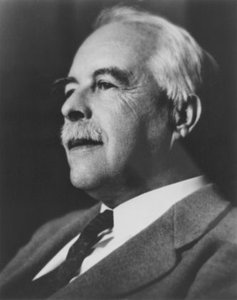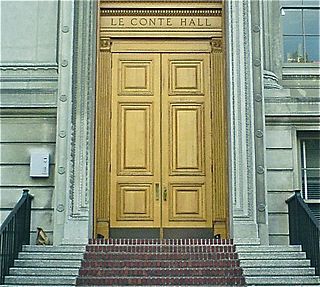
Gilbert Newton Lewis was an American physical chemist and a dean of the college of chemistry at University of California, Berkeley. Lewis was best known for his discovery of the covalent bond and his concept of electron pairs; his Lewis dot structures and other contributions to valence bond theory have shaped modern theories of chemical bonding. Lewis successfully contributed to chemical thermodynamics, photochemistry, and isotope separation, and is also known for his concept of acids and bases. Lewis also researched on relativity and quantum physics, and in 1926 he coined the term "photon" for the smallest unit of radiant energy.

Glenn Theodore Seaborg was an American chemist whose involvement in the synthesis, discovery and investigation of ten transuranium elements earned him a share of the 1951 Nobel Prize in Chemistry. His work in this area also led to his development of the actinide concept and the arrangement of the actinide series in the periodic table of the elements.
Edwin Mattison McMillan was an American physicist credited with being the first to produce a transuranium element, neptunium. For this, he shared the 1951 Nobel Prize in Chemistry with Glenn Seaborg.

The UC Berkeley College of Chemistry is one of the fifteen schools and colleges at the University of California, Berkeley. It houses the department of chemistry and the department of chemical and biomolecular engineering.

Emilio Gino Segrè was an Italian and naturalized-American physicist and Nobel laureate, who discovered the elements technetium and astatine, and the antiproton, a subatomic antiparticle, for which he was awarded the Nobel Prize in Physics in 1959 along with Owen Chamberlain.

The Metallurgical Laboratory was a scientific laboratory at the University of Chicago that was established in February 1942 to study and use the newly discovered chemical element plutonium. It researched plutonium's chemistry and metallurgy, designed the world's first nuclear reactors to produce it, and developed chemical processes to separate it from other elements. In August 1942 the lab's chemical section was the first to chemically separate a weighable sample of plutonium, and on 2 December 1942, the Met Lab produced the first controlled nuclear chain reaction, in the reactor Chicago Pile-1, which was constructed under the stands of the university's old football stadium, Stagg Field.
The campus of the University of California, Berkeley, and its surrounding community are home to a number of notable buildings by early 20th-century campus architect John Galen Howard, his peer Bernard Maybeck, and their colleague Julia Morgan. Subsequent tenures as supervising architect held by George W. Kelham and Arthur Brown, Jr. saw the addition of several buildings in neoclassical and other revival styles, while the building boom after World War II introduced modernist buildings by architects such as Vernon DeMars, Joseph Esherick, John Carl Warnecke, Gardner Dailey, Anshen & Allen, and Skidmore, Owings and Merrill. Recent decades have seen additions including the postmodernist Haas School of Business by Charles Willard Moore, Soda Hall by Edward Larrabee Barnes, and the East Asian Library by Tod Williams Billie Tsien Architects.

The George Herbert Jones Laboratory is an academic building at 5747 S. Ellis Avenue, Chicago, Illinois, on the main campus of the University of Chicago. Room 405 of the building was named a National Historic Landmark in 1967; it was the site where plutonium, the first man-made element, was isolated and measured.
Nobel Prize–winning chemist Glenn T. Seaborg ranked among the most prolific authors in scientific history. With some 50 books, 500 scientific journal articles, hundreds of published speeches, and a lifelong daily journal, a massive volume of written material is available in the Glenn T. Seaborg bibliography with a partial listing given below. Seaborg frequently collaborated with other scientists, co-authors, and staff members to achieve the productivity for which he was so well known. Although most of his writing was in the field of nuclear chemistry, history of science, science education, and science public policy, he has also collaborated on works in sports and collegiate history.

Joseph William Kennedy was an American chemist who co-discovered plutonium, along with Glenn T. Seaborg, Edwin McMillan, and Arthur Wahl. During World War II, he led the CM Division at the Manhattan Project's Los Alamos Laboratory, where he oversaw research onto the chemistry and metallurgy of uranium and plutonium. After the war, he was recruited as a professor at Washington University in St. Louis, where he is credited with transforming a university primarily concerned with undergraduate teaching into one that also boasts strong graduate and research programs. He died of cancer of the stomach at the age of 40.

The National Historic Chemical Landmarks program was launched by the American Chemical Society in 1992 to recognize significant achievements in the history of chemistry and related professions. The program celebrates the centrality of chemistry. The designation of such generative achievements in the history of chemistry demonstrates how chemists have benefited society by fulfilling the ACS vision: Improving people's lives through the transforming power of chemistry. The program occasionally designates International Historic Chemical Landmarks to commemorate "chemists and chemistry from around the world that have had a major impact in the United States".

Plutonium is a chemical element; it has symbol Pu and atomic number 94. It is a silvery-gray actinide metal that tarnishes when exposed to air, and forms a dull coating when oxidized. The element normally exhibits six allotropes and four oxidation states. It reacts with carbon, halogens, nitrogen, silicon, and hydrogen. When exposed to moist air, it forms oxides and hydrides that can expand the sample up to 70% in volume, which in turn flake off as a powder that is pyrophoric. It is radioactive and can accumulate in bones, which makes the handling of plutonium dangerous.

Havemeyer Hall is a historic academic building located in Columbia University in New York City.
The history of the University of California, Berkeley, begins on October 13, 1849, with the adoption of the Constitution of California, which provided for the creation of a public university. On Charter Day, March 23, 1868, the signing of the Organic Act established the University of California, with the new institution inheriting the land and facilities of the private College of California and the federal funding eligibility of a public agricultural, mining, and mechanical arts college.

The bismuth-phosphate process was used to extract plutonium from irradiated uranium taken from nuclear reactors. It was developed during World War II by Stanley G. Thompson, a chemist working for the Manhattan Project at the University of California, Berkeley. This process was used to produce plutonium at the Hanford Site. Plutonium was used in the atomic bomb that was used in the atomic bombing of Nagasaki in August 1945. The process was superseded in the 1950s by the REDOX and PUREX processes.

Larned (Larry) Brown Asprey was an American chemist noted for his work on actinide, lanthanide, rare-earth, and fluorine chemistry, and for his contributions to nuclear chemistry on the Manhattan Project and later at the Los Alamos National Laboratory.

LeConte Hall is the former name of a building on the campus of the University of California, Berkeley, which is home to the physics department. LeConte Hall was one of the largest physics buildings in the world at the time it was opened in 1924, and was also the site of the first atom collider, built by Ernest O. Lawrence in 1931.
Ralph Arthur James was an American chemist at the University of Chicago who co-discovered the elements curium (1944) and americium (1944–1945). Later he worked at UCLA and for the Lawrence Livermore laboratory in California.

















